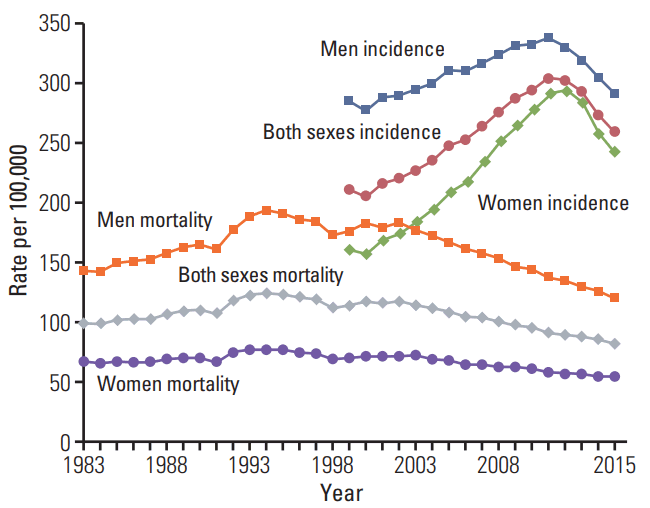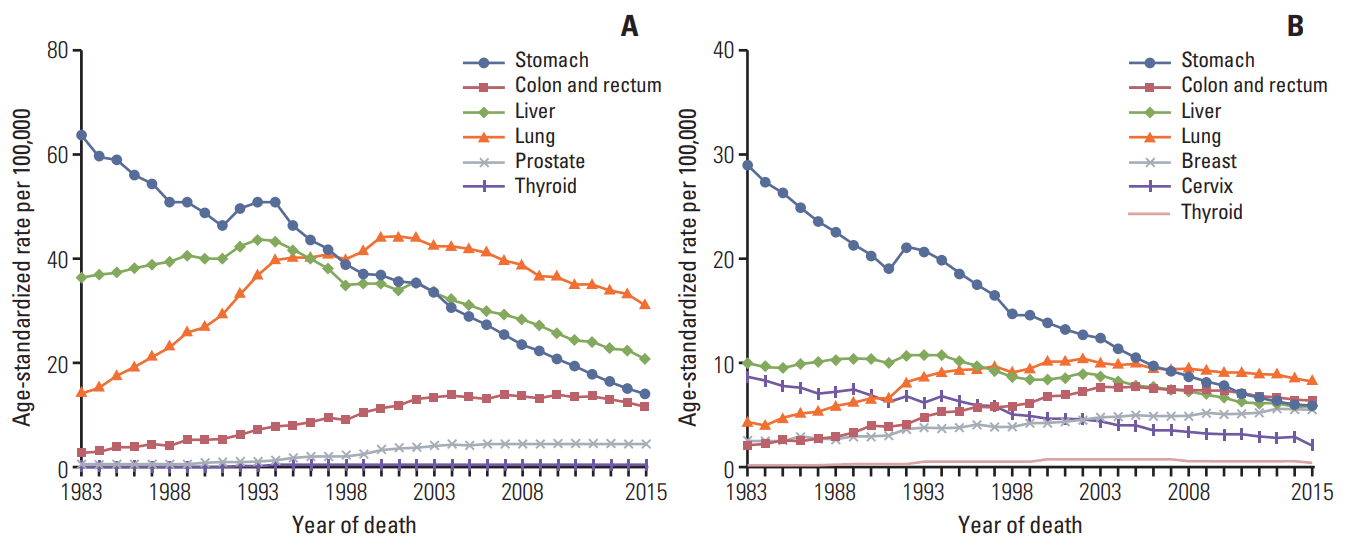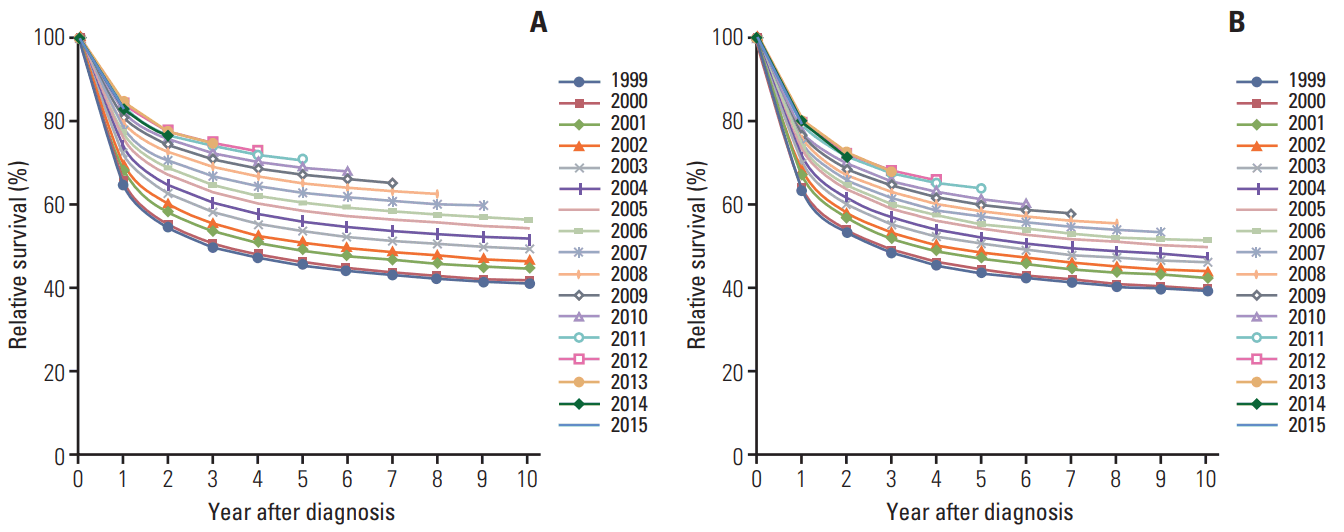AbstractPurposeThis study presents the 2015 nationwide cancer statistics in Korea, including the incidence, survival, prevalence, and mortality.
Materials and MethodsCancer incidence data from 1999 to 2015 was obtained from the Korea National Cancer Incidence Database and followed until December 31, 2016. Mortality data from 1983 to 2015 were obtained from Statistics Korea. The prevalence was defined as the number of cancer patients alive on January 1, 2016, among all cancer patients diagnosed since 1999. Crude and age-standardized rates (ASRs) for incidence, mortality and prevalence and 5-year relative survivals were also calculated.
ResultsHerein, 214,701 and 76,855 Koreans were newly diagnosed and died from cancer in 2015, respectively. The ASRs for cancer incidence and mortality in 2015 were 258.9 and 82.0 per 100,000, respectively. The overall cancer incidence rate has increased significantly by 3.4% annually from 1999 to 2012, and started to decrease after 2012 (2012-2015, annual percent change, –6.1%). However, the overall cancer mortality has decreased 2.7% annually since 2002. The 5-year relative survival rate for patients diagnosed with cancer between 2011 and 2015 was 70.7%, an improvement from the 41.2% for patients diagnosed between 1993 and 1995.
IntroductionCancer is a major life-threatening disease worldwide. Approximately 14.1 million patients were newly diagnosed with cancer and 8.2 million people died from cancer in 2012 worldwide [1]. The global burden of cancer is expected to grow rapidly due to aging population [2].
In Korea, cancer accounts for one in four deaths and more than 200,000 new cancer cases were diagnosed in 2014 [3]. The number of cancer incidences and deaths are expected to increase with the aging population and westernized lifestyles [4]. Additionally, the economic burden of cancer in Korea increased approximately 1.8-fold, from $11,424 to $20,858 million, between 2000 and 2010 [5].
In this context, cancer statistics are the most important indicator of the national cancer burden and can be used to form cancer prevention and control strategies. This study aims to provide nationwide cancer statistics including the incidence, survival, prevalence, and mortality in 2015.
Materials and Methods1. Data sourcesThe Korea Central Cancer Registry (KCCR) was established by the Ministry of Health and Welfare in 1980 as a nationwide hospital-based cancer registry. Since 1999, the KCCR has collected cancer incidence data for the entire nation by compiling a nationwide hospital-based KCCR database that contains data from regional cancer registry programs. The KCCR currently provides the nationwide cancer incidence, survival, and prevalence statistics annually [6].
The KCCR constructed the Korea National Cancer Incidence Database (KNCI DB) using hospitals data, 11 population-based registries, and additional medical chart reviews. The KNCI DB contains information regarding the age, sex, address, date of diagnosis, primary cancer site, histological type, most valid diagnostic method, and Surveillance, Epidemiology, and End Results (SEER) stage. The completeness of cancer incidence data for 2015 was estimated to be 98.2% based on the method proposed by Ajiki et al. [7]. The mid-year population and cancer mortality data from 1983 to 2015 were obtained from Statistics Korea [8]. To ascertain vital status and to calculate survival and prevalence, the KNCI DB was linked to the mortality data and population registration data established by the Ministry of the Interior and Safety.
2. ClassificationAll incident cases were registered according to the International Classification of Diseases for Oncology, third edition [9], and converted to the International Classification of Diseases, 10th edition (ICD-10) codes [10]. The mortality cases were registered according to ICD-10 codes. All cancer cases were reported based on the 24 cancer types.
3. Statistical analysesRates were expressed as crude and age-standardized rates (CR and ASR, respectively) per 100,000 individuals. The CR was calculated as the total number of incidence/mortality cases divided by the mid-year population for the specified years. The ASR is a weighted average of the age-specific rates, where the weights are the proportions of persons in the corresponding age groups of a standard population [11]. In this report, ASRs were calculated using Segi’s world standard population [12]. The cumulative risk of developing cancer from birth to life expectancy was calculated using cumulative rates; that is, the sum of the age-specific rates from birth to life expectancy, as follows [13]:
Trends in incidence/mortality rates were summarized as an annual percentage change (APC) by using a Joinpoint regression. APC is the average percentage change of rates and is calculated as follows [11]:
, where log(Ry)=b0+b1y,
log(Ry) is the natural log transformed age standardized rates.
y=year, b0=intercept, b1=slope
The survival duration for each cancer case was calculated as the interval between the date of the initial diagnosis and the date of death, date of loss to follow-up, or closing date for follow-up. The 5-year relative survival rates (RSRs) were calculated as the ratios of the observed survival of the cancer patients to the expected survival of the general population, which was derived from the standard life table provided by Statistics Korea. Trends in 5-year RSRs were evaluated as percentage differences in 5-year RSRs from 1993-1995 and 2011-2015. RSRs were calculated using the Ederer II method [14] with some minor corrections, based on an algorithm established by Paul Dickman [15].
Prevalent cases were defined as the number of cancer patients alive on January 1, 2016 among all cancer patients diagnosed between 1999 and 2015. Limited-duration prevalences were calculated using SEER*Stat software. Any p-values less than 0.05 were considered statistically significant. SEER*Stat 8.2.1 (National Cancer Institute, Bethesda, MD), Joinpoint 4.1.1 (National Cancer Institute), and SAS 9.4 (SAS Institute Inc., Cary, NC) were used in this report.
Selected Findings1. IncidenceA total of 214,701 cases were newly diagnosed with cancer during 2015 (Table 1). Of these cases, 113,335 (52.8%) were men and 101,366 (47.2%) were women. Stomach cancer was the most commonly diagnosed cancer in 2015, followed by colorectal, thyroid, lung, and breast cancer. The overall cumulative risk of developing cancer from birth to life expectancy was 35.3%. However, the cumulative risk of developing cancer from birth to life expectancy was higher in men (37.9%) than in women (32.0%) (data not shown).
The total CR and ASR for the overall cancer incidences in 2015 were 421.4 and 258.9 per 100,000, respectively (Table 2). According to sex, the CRs for all sites combined were 445.2 in men and 397.6 in women. The ASRs were 291.7 and 241.1 in men and women, respectively. Stomach cancer (CR, 76.8) was the most common cancer in men, followed by lung (CR, 66.8), colorectal (CR, 62.5), liver (CR, 46.1), and prostate cancer (CR, 40.1). These five cancers accounted for 65.7% of the newly diagnosed cases in men during the study period. In contrast, thyroid cancer (CR, 77.1) was the most common cancer among women, followed by breast (CR, 75.1), colorectal (CR, 42.7), stomach (CR, 37.9), and lung cancer (CR, 28.4), which five cancers accounted for 65.7% of the cases in women.
2. MortalityIn 2015, the total number of deaths from cancer was 76,855, accounting for 27.9% of all deaths (Table 3). In terms of sex, 62.0% and 38.0% of cancer deaths occurred in men and women, respectively (Table 1).
The total CR and ASR for cancer deaths were 150.8 and 82.0 per 100,000, respectively, in 2015 (Table 4). The total CR and ASR for cancer deaths per 100,000 were higher among men (CR, 187.3; ASR, 119.6) than among women (CR, 114.4; ASR, 54.6).
According to cancer sites, lung cancer (CR, 49.8) was the leading cause of death in men, followed by liver (CR, 32.9), stomach (CR, 21.6), colorectal (CR, 18.5), and pancreatic cancer (CR, 11.4). The top five causes of deaths from cancer in women included lung (CR, 18.5), colorectal (CR, 14.1), stomach (CR, 11.8), liver (CR, 11.5), and pancreatic cancer (CR, 9.9).
3. Trends in cancer incidence and mortality
Fig. 1 shows the trends in cancer incidence and mortality from 1983 to 2015. The ASR for all-cancer incidence increased by 3.4% annually from 1999 to 2012, and then began to decrease from 2012 to 2015 (APC, –6.1%) (Table 5, Fig. 1). The incidence of cancers in stomach, colorectum, lung and thyroid started to decrease around 2011. Especially, the ASR for thyroid cancer has increased rapidly 22.8% from 1999 to 2011, but then decreased swiftly 13.3% annually starting in 2011. Incidence of breast cancer has increased constantly throughout the period, but the APC slowly started to decrease since 2007. Conversely, the incidence rates of cervix and liver showed a constant decrease for the whole period. The incidence of liver cancer decreased drastically starting in 2010 (Fig. 2).
The ASR for the all-cancer mortality rate has been increased until 2002 (Table 6, Fig. 1). After that year, it began to decrease (2002-2015, APC, –2.7%). Similar patterns were observed in men and women. According to cancer sites, the mortality rates for most cancers including those of the lung, liver, colorectum, gallbladder, leukemia, brain and central nervous system, cervix uteri, and thyroid started to decrease in the early 2000s. However, the mortality rates for cancers of the stomach, larynx, testis, bladder, and non-Hodgkin lymphoma decreased starting in 1999 (Fig. 3). Cancers in the pancreas, breast, and prostate showed constant increasing trends for the whole period.
4. Age-specific incidenceLeukemia was the most commonly diagnosed cancer among children aged 0-14 years (Table 7). Thyroid cancer was the most common cancer among adolescents and young adults between 15 and 34 years of age. For men, the incidence rate of cancer increased before age 70 years (Fig. 4A). Stomach cancer was the most commonly diagnosed cancer among men aged 35 to 64 years, while lung cancer was the most common among men aged ≥ 65 years. In contrast, breast cancer was most commonly diagnosed among women aged 35-64 years, while colorectal cancer was the most common among women aged ≥ 65 years. The incidence rates for thyroid and breast cancer showed an inverted U-shaped pattern when analyzed according to age (Fig. 4B).
5. Survival ratesThe 5-year RSRs for all cancer combined improved remarkably in both sexes, from 41.2% in 1993-1995 to 70.7% in 2011-2015 (Table 8, Fig. 5A). After excluding thyroid cancer, the 5-year RSRs for all cancer still increased from 1993 to 2015 (Fig. 5B).
The 5-year RSR during 2011-2015 for all cancers combined was 62.8% in men and 78.4% in women, respectively. The 5-year RSR for thyroid cancer was over 100%, while the 5-year RSRs for testis, prostate, and breast cancer were over 90% in 2011-2015 for both sexes. However, the 5-year RSR for pancreatic cancer was only 10.8% in both sexes in 2011-2015.
When compared to the 5-year RSR for men in 1993-1995, prostate cancer diagnosed from 2011 to 2015 showed the most outstanding improvement, followed by stomach, leukemia, “lip, oral cavity and pharynx” and liver cancer. Among women, stomach cancer diagnosed during 2011-2015 showed the greatest improvement in 5-year RSRs compared to those between 1993 and 1995, followed by leukemia, lung, colorectal, and kidney cancer.
6. PrevalenceA total of 1,611,487 prevalent cancer cases were identified on January 1, 2016 (Table 1). Of these cases, 707,977 (43.9%) were men and 903,510 (56.1%) were women. The crude and age-standardized prevalence rates for overall cancer were 3,162.8 per 100,000 individuals and 1,956.9 per 100,000 individuals for both sexes, respectively, in 2015 (Table 9).
The five most common cancers for men were stomach (CR, 668.9), colorectal (CR, 516.8), prostate (CR, 272.8), thyroid (CR, 236.3), and liver cancer (CR, 180.2). In contrast, thyroid cancer was most common in women (CR, 1156.8), followed by breast (CR, 699.8), colorectal (CR, 349.4), stomach (CR, 340.1), and cervix uteri cancer (CR, 198.0).
Analysis of the period after cancer diagnosis revealed that thyroid (15.8%) cancer was the most prevalent cancer within 2 years after diagnosis, followed by stomach (14.3%) and colorectal cancer (13.2%) (Fig. 6). Thyroid cancer (27.4%) was most prevalent for 2-5 years, followed by stomach (14.5%) and colorectal cancer (13.6%). After 5 years, thyroid cancer (21.7%) was the most prevalent cancer, followed by stomach (17.6%) and colorectal cancer (14.0%).
AcknowledgmentsThis work was supported by a research grant from the National Cancer Center (No. 1610200), Republic of Korea. The authors are indebted to the Korea Central Cancer Registry (KCCR)-affiliated hospitals, non-KCCR-affiliated hospitals, the National Health Insurance Service and Statistics Korea for the data collection.
NotesThe Community of Population-Based Regional Cancer Registries Chang-Hoon Kim (Busan Cancer Registry, Pusan National University Hospital), Cheol-In Yoo (Ulsan Caner Registry, Ulsan University Hospital), Jong-Hyock Park (Chungbuk Cancer Registry, Chungbuk National University Hospital), Hae-Sung Nam (Daejeon/Chungnam Cancer Registry, Chungnam National University and Hospital), Jung-Sik Huh (Jeju Cancer Registry, Jeju National University and Hospital), Jung-Ho Youm (Chonbuk Cancer Registry, Chonbuk National University Hospital), Eurah Goh (Kangwon Cancer Registry, Kangwon National University Hospital), Nam-Soo Hong (Daegu/Gyeongbuk Cancer Registry, Kyungpook National University Medical Center), Sun-Seog Kweon (Gwangju/Jeonnam Cancer Registry, Chonnam National University Hospital), Woo-Chul Kim (Incheon Cancer Registry, Inha University Hospital), Yune-Sik Kang (Gyeongnam Cancer Registry, Gyeongsang National University & Hospital) Fig. 1.Annual age-standardized cancer incidence and death rates by sex for all sites from 1983 to 2015 in Korea. Age standardization was based on the Segi’s world standard population. 
Fig. 2.Trends in age-standardized incidences of selected cancers by sex from 1999 to 2015 in Korea. Age standardization was based on the Segi’s world standard population. (A) Men. (B) Women. 
Fig. 3.Annual age-standardized cancer mortalities of selected cancers by sex from 1983 to 2015 in Korea. (A) Men. (B) Women. Age-standardization was based on the Segi’s world standard population. 
Fig. 5.Trends in relative survival by year of diagnosis from 1999 to 2014. (A) All sites for both sexes. (B) All sites except thyroid cancer for both sexes. 
Fig. 6.Prevalence of common cancer sites by time period after cancer diagnosis. Prevalent cases were defined as the number of cancer patients alive on January 1, 2016 among all cancer patients diagnosed between 1999 and 2015. 
Table 1.Cancer incidence, deaths and prevalence by sex in Korea, 2015
Table 2.Crude and age-standardized cancer incidence rates by sex in Korea, 2015
Table 3.The top 10 leading causes of death in Korea, 2015
Source: Mortality Data, 2015, Statistics Korea [8]. Table 4.Crude and age-standardized cancer mortality rates by sex in Korea, 2015
Table 5.Trends in cancer incidence rates from 1999 to 2015 in Korea
Table 6.Trends in cancer mortality rates from 1999 to 2015 in Korea
Table 7.The five common sites/types of cancer incidence by age group and sex in Korea, 2015 Table 8.Trends in the 5-year relative survival rates (%) by year of diagnosis from 1993 to 2015 in Korea
Table 9.Crude and age-standardized rates of cancer prevalence by sex on January 1, 2016 in Korea
a) Crude prevalence rate: number of prevalent cases divided by the corresponding person-years of observation. Prevalent cases were defined as patients who were diagnosed between January 1, 1999 and December 31, 2015 and who were alive on January 1, 2016. Multiple primary cancer cases were counted multiple times, References1. Ferlay J, Soerjomataram I, Ervik M, Dikshit R, Eser S, Mathers C, et al. GLOBOCAN 2012 v1.0. Cancer Incidence and Mortality Worldwide: IARC CancerBase No. 11 [Internet]. Lyon: International Agency for Research on Cancer; 2013. [cited 2017 Jan 20]. Available from: http://globocan.iarc.fr
2. GBD 2013 Mortality and Causes of Death Collaborators. Global, regional, and national age-sex specific all-cause and cause-specific mortality for 240 causes of death, 1990-2013: a systematic analysis for the Global Burden of Disease Study 2013. Lancet. 2015;385:117–71.
3. Jung KW, Won YJ, Oh CM, Kong HJ, Lee DH, Lee KH, et al. Cancer statistics in Korea: incidence, mortality, survival, and prevalence in 2014. Cancer Res Treat. 2017;49:292–305.
4. Jung KW, Won YJ, Oh CM, Kong HJ, Cho H, Lee DH, et al. Prediction of cancer incidence and mortality in Korea, 2015. Cancer Res Treat. 2015;47:142–8.
5. Lee KS, Chang HS, Lee SM, Park EC. Economic burden of cancer in Korea during 2000-2010. Cancer Res Treat. 2015;47:387–98.
6. Shin HR, Won YJ, Jung KW, Kong HJ, Yim SH, Lee JK, et al. Nationwide cancer incidence in Korea, 1999-2001: first result using the national cancer incidence database. Cancer Res Treat. 2005;37:325–31.
7. Ajiki W, Tsukuma H, Oshima A. Index for evaluating completeness of registration in population-based cancer registries and estimation of registration rate at the Osaka Cancer Registry between 1966 and 1992 using this index. Nihon Koshu Eisei Zasshi. 1998;45:1011–7.
8. Statistics Korea [Internet]. Daejeon: Statistics Korea; 2017. [cited 2017 Jan 28]. Available from: http://kosis.kr
9. Fritz A, Percy C, Jack A, Shanmugaratnam K, Sobin L, Parkin DM, et al. International classification of diseases for oncology. 3rd edGeneva: World Health Organization; 2000.
10. World Health Organization. International statistical classification of diseases and related health problems. 10th rev. edGeneva: World Health Organization; 1994.
11. Howlader N, Noone AM, Krapcho M, Garshell J, Miller D, Altekruse SF, et al. SEER Cancer Statistics Review, 1975-2013 [Internet]. Bethesda, MD: National Cancer Institute; 2016. [cited 2017 Feb 20]. Available from: http://seer.cancer.gov/csr/1975_2013/
12. Segi M. Cancer mortality for selected sites in 24 countries (1950-1957). Sendai: Tohoku University School of Medicine; 1960.
13. Day NE. Cumulative rates and cumulative riskIn : Muir C, Waterhouse J, Mack T, Powell J, Whelan S, editors. Cancer incidence in five continents, Vol. V. IARC Scientific Publications No. 88. Lyon: International Agency for Research on Cancer; 1987. p. 787–9.
14. Ederer F, Heise H. Instructions to IBM 650 programmers in processing survival computations. Methodological note No. 10Bethesda, MD: National Cancer Institute; 1959.
15. Paul Dickman [Internet]. Stockholm: PaulDickman.com; 2016. [cited 2016 Jan 14]. Available from: http//www.pauldickman.com
|
|
||||||||||||||||||||||||||||||||||||||||||||||||||||||||||||||||||||||||||||||||||||||||||||||||||||||||||||||||||||||||||||||||||||||||||||||||||||||||||||||||||||||||||||||||||||||||||||||||||||||||||||||||||||||||||||||||||||||||||||||||||||||||||||||||||||||||||||||||||||||||||||||||||||||||||||||||||||||||||||||||||||||||||||||||||||||||||||||||||||||||||||||||||||||||||||||||||||||||||||||||||||||||||||||||||||||||||||||||||||||||||||||||||||||||||||||||||||||||||||||||||||||||||||||||||||||||||||||||||||||||||||||||||||||||||||||||||||||||||||||||||||||||||||||||||||||||||||||||||||||||||||||||||||||||||||||||||||||||||||||||||||||||||||||||||||||||||||||||||||||||||||||||||||||||||||||||||||||||||||||||||||||||||||||||||||||||||||||||||||||||||||||||||||||||||||||||||||||||||||||||||||||||||||||||||||||||||||||||||||||||||||||||||||||||||||||||||||||||||||||||||||||||||||||||||||||||||||||||||||||||||||||||||||||||||||||||||||||||||||||||||||||||||||||||||||||||||||||||||||||